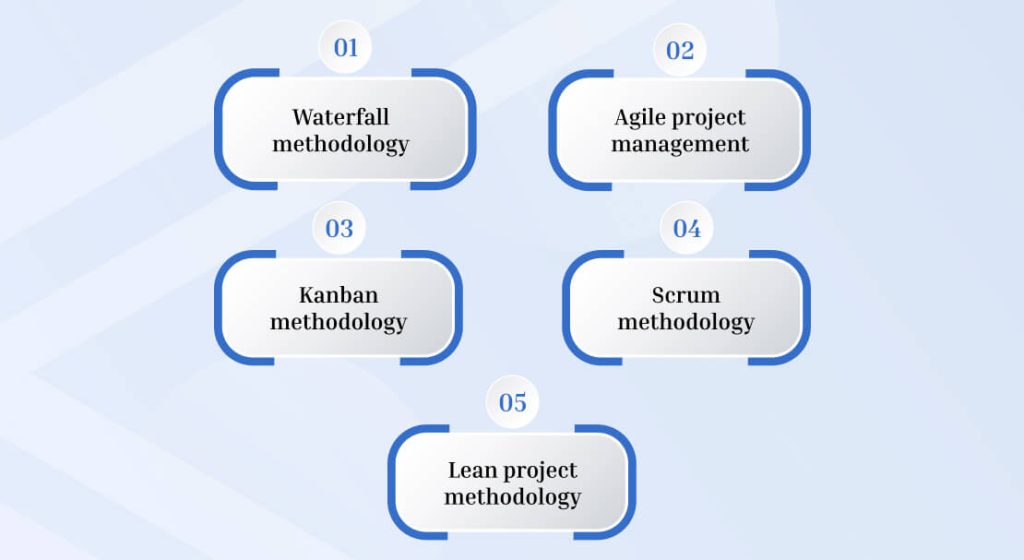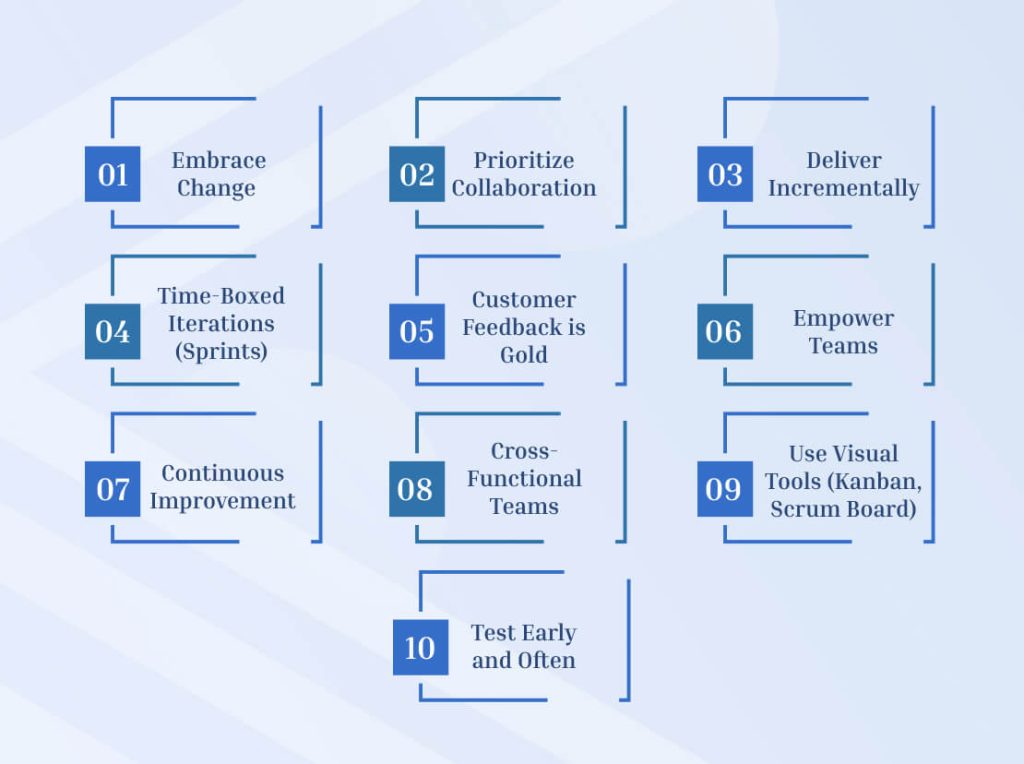Agile Methodology
The Agile Methodology has quickly evolved into one of the leading approaches to project management and is an integral component of the software development process, as it increases flexibility while minimizing problems associated with waterfall models.
Information technology has been revolutionized by agile development over the past 25-30 years. A Business Review article notes that Agile methodologies involve new principles, values, and practices that have led to increased success rates, quality, speed of market, and motivation among IT teams over the last decade.” Furthermore, its spread reaches industries, functions, and even C-Suite executives!
The Agile methodology involves iterative software development company that involves the collaboration of product owners and cross-functional teams. It is characterized by rapid evolution of requirements and solutions through collaboration, as well as handling changes efficiently and delivering value in a predictable manner. In contrast to traditional methodology, the unique process allows teams to produce value more quickly because they don’t have to deal with interruptions from outside changes. In addition, teams can produce quicker returns with larger predictability and greater timeliness than they could with traditional methodologies.
Project Management Methodologies
Wait, there’s more than one way to manage a project? Absolutely! There’s a whole toolbox of project management methodologies, each with its unique style and benefits. Let’s dive in and explore these diverse approaches that help teams shine.
Project management methodologies are like different recipes for success in the project world. They bring their flavor to the table, making projects smoother and more efficient.
Now, let’s take a sneak peek at some of the top project management methodologies. It’s like having a backstage pass to streamlined project collaboration.
And hey, before we embark on this journey, why not test drive Wrike with a free trial? Experience the magic of our features, collaborate seamlessly with your team, and watch your projects come to life in one unified platform.
Excited? Let’s explore the wonderful world of project management methodologies together!
Types of Project Management Framework

There are many types of frameworks for managing projects that can be used by businesses to create their plans for projects. Here are some examples:
Waterfall methodology
The waterfall method is a linear framework that defines assignments in the order the order that team members complete them. By breaking a project down into phases, this framework helps organize similar jobs and simplifies management tasks because the progress can be easily reviewed. The steps of the waterfall method are:
- Project requirements: Teams for the project write down all needs and information on what the project is required to accomplish.
- Design: During this stage, a team creates an action plan to achieve the goals related to the completion of the project.
- Implementation: The plan goes into effect, and managers review the progress.
- Control The control phase will analyze the performance of the project and compare it to the original plan.
- The closure finalization phase is when the project is complete and the project team receives the client’s approval to finalize its work.
This kind of framework enables the management to monitor progress because tasks are separated into phases. This also aids communication between the client and team members.
Project management for critical chains
Critical chain project management is one type of framework that pinpoints the most efficient and cost-effective path to completion by analyzing the resources. For this, the team members outline the project’s goals, available resources, and deadlines to complete certain tasks. They plan their jobs depending on when the needed materials are in place. This approach is beneficial when a team has multiple projects that may use the same resources. It will work for any size project.

Ready to Embrace Agile? Schedule Your Free Consultation!

Pooja Upadhyay
Director Of People Operations & Client Relations
Agile project management
Agile project management centers on the team members working on the project and segments the project cycle into more manageable pieces. In this kind of system, a team focuses on reacting to the changes occurring rather than establishing a strict schedule to adhere to. For instance, a website development team that uses agile project management has designers develop applications, and testers look over the application and implement changes as required.
The methodology is based on these fundamental guidelines:
- Fulfilling the needs of the client
- Accepting requirements changes
- Collaborating with the stakeholders
- Entrusting the team to meet goals
- Contacting people in person as frequently as possible
- Achieving a consistent and steady workflow
- The definition of success is based on how the product works
- Improved team efficiency
Kanban methodology
Kanban is a framework for managing projects that aid in visualizing the plan and work of the project. The Kanban board is a web-based tool that monitors workflows, allows teams to identify and organize tasks, and also displays the project’s schedule on a digital panel with lists. The lists help separate tasks into project phases, and every job is assigned a color code to arrange workflow. Kanban generally groups these tasks into a list of queued tasks that include in-progress and completed tasks.
Kanban is a great tool for collaboration. Kanban helps facilitate collaboration and monitor team goals. An overview of everyone in the team and their tasks and activities.
Scrum methodology
Scrum methodology breaks down complex work into small tasks that are actionable and quick to accomplish. This type of system requires a group to determine what charges to work on and create plans for these tasks. When the time is allotted, the group reviews its progress and plans the following couple of weeks of lessons.
The benefit of using this Scrum Framework is the software can assign job duties and roles as well as help track the performance of employees.
Lean project methodology
Lean project methodology is a method that helps to reduce the usage of resources and enhance work processes by utilizing workflows and eliminating any unneeded tasks and resources. This is accomplished by reviewing the resources and assignments that the project needs and notifying managers of redundancy as well as the opportunity to combine the resources or reads.
This type of framework for project management has several components, which include:
- Determine value: The project determines whether the final product will benefit customers. This allows customers to prioritize their needs and is focused on the essential functionality of products and services.
- Create a value stream map: This requires visualizing the workflow in the present and determining an ideal workflow for maximum efficiency from the beginning of a project’s completion.
- Be responsive to customer needs. Lean frameworks require teams to act whenever customers ask for it. This prevents using resources to do work that a customer doesn’t require.
- Enhancing processes: Lean process management frameworks seek to constantly improve workflows and processes by regularly assessing work processes and the performance of projects.

What Are The Benefits of Following a Project Management Framework?
In the world of project management, having a framework is like having a trusty toolkit for both project managers and teams. It’s not just a set of rules; it’s a flexible guide that lets you use the best strategies for each unique situation. According to Parallel, having this framework in place makes your team super skilled at dealing with unexpected changes in a project.
Now, let’s dive into some awesome benefits of using project management frameworks:
1. Consistency
With a project management framework, everyone in the organization follows the same set of processes. This means projects get planned, and deadlines get set with super precision.
2. Clarity:
Picture this: A framework that lays out all your project tasks and the tools you need. Make sure everything is clear when it’s time to roll up your sleeves and get things done!
3. Simplification:
Big projects can be overwhelming, right? Well, a project management framework breaks them down into smaller, manageable tasks. This makes it a breeze for managers to hand out assignments and for teams to handle the workload.
4. Optimization:
Have you ever wondered where all your time and money go in a project? A project management framework helps managers figure that out. It’s like having a superhero ability to allocate resources smartly and make future projects even better.
5. Communication:
Regular team meetings, thanks to the framework, keep everyone on the same page. Project managers become communication champs, talking effectively with colleagues and keeping the information flowing smoothly.
Top 10 Agile Best Practices

1. Embrace Change:
In the Agile world, Change isn’t the enemy; it’s a friend. Be ready to adapt and welcome changes in requirements, even late in the game. It’s all about delivering what the customer truly needs.
2. Prioritize Collaboration:
Teamwork makes the dream work! Agile thrives on Collaboration among team members, stakeholders, and customers. Regular communication and working together lead to better outcomes.
3. Deliver Incrementally:
Instead of going for the grand reveal at the end, Agile promotes delivering smaller, incremental pieces of the project. It keeps stakeholders in the loop and ensures that what’s delivered is genuinely valuable.
4. Time-Boxed Iterations (Sprints):
Agile divides the project into time-boxed iterations known as sprints. This helps in maintaining a consistent pace and ensures that progress is measurable and predictable.
5. Customer Feedback is Gold:
Agile puts a premium on customer satisfaction. Regularly gather feedback from customers and end-users. It’s not just about meeting requirements but exceeding expectations.
6. Empower Teams:
Trust your teams. Please give them the autonomy to make decisions and solve problems. Agile thrives when teams are empowered to take ownership of their work.
7. Continuous Improvement:
Agile isn’t a set-it-and-forget-it deal. Regularly reflect on what’s working and what can be improved. Embrace a culture of constant Improvement to refine processes.
8. Cross-Functional Teams:
Agile encourages having diverse skills within a team. A mix of talents ensures that tasks can be handled efficiently without dependencies on external teams.
9. Use Visual Tools (Kanban, Scrum Board):
Make things visible! Visual tools like Kanban boards or Scrum boards help in tracking progress, making it easy for everyone to understand where things stand.
10. Test Early and Often:
Testing isn’t just a phase; it’s integral to the Agile process. Test early, test often. This ensures that the product is high quality and meets the desired standards.
Conclusion
The amalgamation of Agile and other project management methodologies creates a robust ecosystem for project success. It’s not just about choosing one method but understanding when and how to apply the right tool from the project management toolkit. So, embark on your project management journey with the proper methodologies, adapt, collaborate, and witness your projects come to life seamlessly.

Hire our expert developers who follow agile methodology to build Scaleable software for your business’s success.

Pooja Upadhyay
Director Of People Operations & Client Relations

